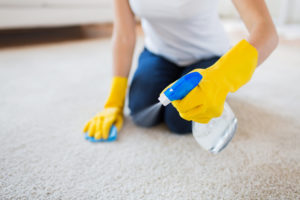Yesterday morning, as I watched my husband use about 1/4 cup of Windex to clean a counter less than six feet long, a blog topic came to mind.
I recalled a year prior when I was staying with our manager for a weekend retreat of sorts. Her husband did a load of laundry that contained a pair of my work pants. He returned the pants and I wore them to work the next day. The scent of laundry detergent coming off of those pants all day was overpowering. I commented to her that I think her husband (like mine) succumbs to a very common misconception that more soap is better. She laughed and asked if I could explain the science behind that to her husband since he was using about 2 cups of detergent per load and I graciously took up the conversation at dinner that night.
The conversation went something like this:
Firstly, cleaning product manufacturers spend a ton of time and money testing their products before releasing them to the market.
The general idea of cleansers is that they surround dirt particles, lifting them off the surface of what you are cleaning and literally suspending them in the water that is present when you clean. The manufacturers, better yet, their scientists, have figured out the exact amount of solution needed to perfectly suspend those particles allowing you to rinse or wipe them away. Now remembering that water is a very good cleanser on its own, then it makes sense to follow the instructions on your labels regarding amounts and dilutions.
Secondly, using too much of anything soapy can be disastrous.
Soap is very difficult to rinse away, and even the soapless products that we use at MNC if used in excess are difficult to rinse out. So if you overuse a detergent, you end up with a clean fabric full of sticky residue. What does sticky residue do by nature? Collect Dirt!!! (If you have ever had a carpet cleaner out, but felt the carpets looked dirty only a few short months later, this is why. A cleaning should last you 6 months to a year depending on your traffic.)
Thirdly, the first thing a cleaner learns – in their first week – is the cleaning pie.
The cleaning pie helps us to know what to do when we have one variable that is complicated.

You have four equal quadrants:
- Chemical (your soap);
- Heat (your water temperature)
- Agitation (how much you scrub) and
- Time (how long it sits on the fabric – we call this dwell time)
If you decrease one, you have to increase another. The pie needs to remain whole, but your variables can change. For example, when we clean a wool carpet or fabric, we don’t want to use as much heat, so we may use more dwell time to give the cleanser more time to do its work.
What it also means is that you rarely need to let your cleaner sit on the surface for a long time and then use hot water, a ton of soap, a huge amount of scrubbing. It’s overkill!
So, best practice at home:
- Follow the manufacturers instruction for amounts and dilutions.
- If you change one variable, compensate on another and rarely would we recommend additional cleanser.
- Make sure you can rinse! This is the key to actually keeping your items clean!
Follow this and your items will come out as clean as is safe for the fabric, and will stay cleaner longer.
Happy Cleaning!


